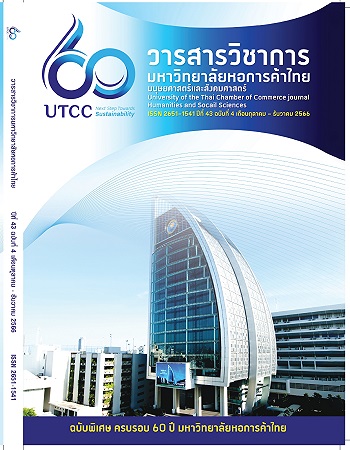Human Capital in Digital Technology Proficiency and Access to State Assistance for the Informal Labor Forces in Songkhla Province
Main Article Content
Abstract
The informal labor force is a crucial driving force for the economy of Songkhla province. The objective of this research is to compare the differences between individual factors and the level of proficiency in using digital technology among informal workers in the 16 districts of Songkhla Province. It also aims to study the relationship between factors such as income levels, technological proficiency, and access to state assistance. The sample group used for this study consists of 200,000 informal laborers in Songkhla Province. The study found that informal laborers with varying occupations, educational levels, and technological proficiency levels had significantly different income levels, which was statistically significant. In addition, the study discovered a correlation between access to state assistance, technological proficiency and factors related to income levels. Specifically, groups with lower income levels tended to use technology less and had lower access to state assistance. This implies that factors related to technological proficiency and access to state assistance have a mutually reinforcing relationship. Therefore, formulating economic assistance policies for the informal labor force necessitates promoting income-generating capabilities alongside investing in human capital for digital technology use. This approach will help alleviate income disparities stemming from differences in digital knowledge (digital divide) and simultaneously enable the informal workers to access state assistance in line with economic development policies, leading to widespread benefits (digital dividend).
Article Details

This work is licensed under a Creative Commons Attribution-NonCommercial-NoDerivatives 4.0 International License.
ลิขสิทธิ์ของบทความ
ผลงานที่ได้รับการตีพิมพ์ถือเป็นลิขสิทธิ์ของมหาวิทยาลัยหอการค้าไทย ห้ามมิให้นำเนื้อหา ทัศนะ หรือข้อคิดเห็นใด ๆ ของผลงานไปทำซ้ำ ดัดแปลง หรือเผยแพร่ ไม่ว่าทั้งหมดหรือบางส่วนโดยไม่ได้รับอนุญาตเป็นลายลักษณ์อักษรจากมหาวิทยาลัยหอการค้าไทยก่อน
References
กมลพร สันทัดสำรวจการณ์, และวรวิทย์ จินดาพล. (2561). แนวทางการส่งเสริมสวัสดิการแรงงานนอกระบบในเขตพื้นที่อำเภอเมือง จังหวัดอุดรธานี. วารสารบัณฑิตศึกษา: มหาวิทยาราชภัฏสวนสุนันทา, 11(2), 1-13.
ณัฐพล แสงอรุณ. (2561). การวิเคราะห์ความเหลื่อมล้ำแบบแยกส่วนสองชั้นของเศรษฐกิจเชิงพื้นที่ในประเทศไทย พ.ศ. 2538-2558. วารสารวิชาการ มหาวิทยาลัยหอการค้าไทย มนุษยศาสตร์และสังคมศาสตร์, 38(3), 92-105.
ณัฐวุฒิ อัศวโกวิทวงศ์, ขวัญพร บุนนาค, และนภัส วัฒโนภาส. (2561). ความเหลื่อมล้ำในเมืองมหานคร: บทปริทรรศน์ความรู้ในบริบทประเทศไทย. วารสารสิ่งแวดล้อมสรรค์สร้างวินิจฉัย คณะสถาปัตยกรรมศาสตร์ มหาวิทยาลัยขอนแก่น, 17(2), 157-178.
ดิเรก ปัทมสิริวัฒน์, และดารุณี พุ่มแก้ว. (2560) เงินอุดหนุนเฉพาะกิจและความเหลื่อมล้ำการคลังท้องถิ่นในประเทศไทย. วารสารสถาบันพระปกเกล้า, 15(1), 118-138.
ตะวัน วรรณรัตน์. (2557). การศึกษาเศรษฐกิจนอกภาคทางการในประเทศไทย. วารสารมหาวิทยาลัยศิลปากร, 34(1), 137-159.
นิพนธ์ วงศ์จินดา. (2560). การเติบโตทางเศรษฐกิจและการพัฒนาอสังหาริมทรัพย์ส่วนภูมิภาคของไทย กรณีศึกษา: ภาคใต้ จังหวัดภูเก็ตและสงขลา, วารสารวิจัยและพัฒนา วไลยอลงกรณ์ ในพระบรมราชูปถัมภ์ สาขามนุษยศาสตร์และสังคมศาสตร์, 12(2), 245-256.
ราเชนทร์ ชินทยารังสรรค์. (2554). คุณภาพชีวิตกับการเติบโตทางเศรษฐกิจและการกระจายรายได้. วารสารพัฒนบริหารศาสตร์, 51(1), 1-17.
เรืองศักดิ์ เดชณุกูล, และสมปอง สีชมพู. (2561). ความเหลื่อมล้ำด้านการคลังองค์กรปกครองส่วนท้องถิ่น. วารสารราชภัฏเพชรบูรณ์สาร, 20(2), 11-23.
วันใหม่ นนท์ฐิติพงศ์, และณิชกานต์ พรหมจินดา. (2564). แรงงานนอกระบบ: หนทางการอยู่รอดในยุค New Normal. สืบค้นเมื่อ 21 สิงหาคม 2566, จาก https://www.bot.or.th/th/research-and-publications/articles-and-publications/articles/Article_13Apr2021.html
ศูนย์ประสานงานแรงงานนอกระบบ. (2555). ปฏิรูปประกันสังคมกับคุณภาพชีวิตแรงงาน. สืบค้นเมื่อ 21 สิงหาคม 2566, จาก http://isw-thai.blogspot.com/?view=classic
สถาบันวิจัยเพื่อการพัฒนาประเทศไทย. (2557). เศรษฐกิจนอกระบบ ต้นตอความเสี่ยงของไทย. สืบค้นเมื่อ 15 พฤษภาคม 2562, จาก https://tdri.or.th/2014/04/bangkokbiz-2014-04-29/
สำนักงานศูนย์วิจัยและให้คำปรึกษาแห่งมหาวิทยาลัยธรรมศาสตร์. (2562). โครงการจัดทำดัชนีวัดคุณภาพชีวิตแรงงานนอกระบบและสำรวจข้อมูล แรงงานนอกระบบ(รายจังหวัด) ปีงบประมาณ พ.ศ.2562.กรุงเทพฯ: มหาวิทยาลัยธรรมศาสตร์.
สำนักงานสถิติแห่งชาติ. (2556). การสำรวจแรงงานนอกระบบ พ.ศ. 2556. กรุงเทพฯ: ผู้แต่ง.
สำนักงานสถิติแห่งชาติ. (2560). การสำรวจแรงงานนอกระบบ พ.ศ. 2560. กรุงเทพฯ: ผู้แต่ง.
สำนักงานสถิติแห่งชาติ, สำนักงานสถิติจังหวัดสงขลา. (2560). รายงานสถิติจังหวัดสงขลา พ.ศ. 2560. สืบค้นจาก https://songkhla.nso.go.th/images/nat/%E0%B8%B7nat_1/report_60.pdf
สุชานุช พันธนียะ. (2562). แนวทางการปฏิรูปนโยบายสาธารณะเพื่อลดความเหลื่อมล้ำในสังคมไทย:กรณีนโยบายระบบการเงินระดับฐานราก (Microfinance). วารสารสถาบันพระปกเกล้า, 17(1), 58-74.
Becker, G. S. (1964). Human capital: A theoretical and empirical analysis with special reference to education. Cambridge, MA: National Bureau of Economic Research.
Habibullah, M. S., Din, B. H., & Sanusi, N. A. (2017). Economic growth and catch-up effect between the less developed states and the richer state of Selangor. International Journal of Economic Research, 14(16), 165-173.
Mamuna, M. A., Sohagb, K., & Hassan, M. K. (2017). Governance, resources and growth. Economic Modelling, 63, 238–261.
Stokke, H. E. (2004). Technology adoption and multiple growth paths: An intertemporal general equilibrium analysis of the catch-up process in Thailand. Review of World Economics, 140(1), 80-109.
Tsani, S. (2015). On the relationship between resource funds, governance and institutions: Evidence from quantile regression analysis. Resources Policy, 44: 94–111. doi:10.1016/j.resourpol.2015.01.003
Van den Bergh, J. C. (2004). Evolutionary analysis of the relationship between economic growth, environmental quality and resource scarcity. In R.U. Ayres, D. Simpson, & M. Toman (Eds.), Scarcity and growth revisited: Natural resources and the environment in the new millennium (pp. 177-197). New York, NY: Routledge.
Verspagen, B. (1991). A new empirical approach to catching up or falling behind. Structural Change and Economic Dynamics, 2(2), 359-380. doi:10.1016/S0954-349X(05)80008-6
World Bank. (2016). Digital dividends. Retrieved from https://documents1.worldbank.org/curated/en/896971468194972881/pdf/102725-PUB-Replacement-PUBLIC.pdf
Yusuf, S. (2014). Income inequality and economic growth: The effect of Gini coefficient on GNI (Master thesis, Umeå University). Retrieved from https://www.diva-portal.org/smash/get/diva2:1344997/FULLTEXT01.pdf


